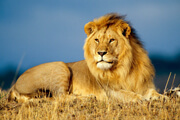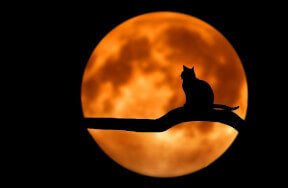Cheetos made the cheetah famous. Find out more about this fast feline!
Physical Characteristics
Cheetahs are an “atypical” member of the cat family due to their unique speed and the fact that they can’t climb. Best known as the fastest land animals, cheetahs can reach speeds of 70-75 miles per hour in short bursts, covering distances of up to 460 m and accelerating from 0-68 mph in three seconds – faster than most supercars!
Tan and black-spotted cheetahs have deep chests, narrow waists, ringed and white-tufted tails, small heads, high-set eyes and black “tear marks” that run from the corners of their eyes down the sides of their noses to their mouths to keep the sunlight out of their eyes so they can see better while hunting (think of football and baseball players, who also paint black stripes below their eyes to keep the sun out of their eyes for better visibility).
 Courtesy of National Geographic
Courtesy of National Geographic
Cheetahs with a rare fur-pattern mutation, where the spots are larger, blotchy and merged, are known as “king cheetahs.”
Cheetahs have semi-retractable claws (this characteristic is only known in three other cat species, and none of the "big" cats), which offer the fast felines extra grip in their high-speed pursuits.
Also unlike “true” big cats, the cheetah can purr as it inhales but can’t roar. In contrast, the big cats can roar but can only purr when exhaling. Still, many experts believe the cheetah is a member of the big cats family – the smallest member, that is.
Hunting Habits
Cheetahs are carnivores (meat eaters) who eat mostly gazelles, springbok and impalas, as well as the occasional wildebeest, zebra and hare. Cheetahs hunt by sight rather than scent, stalking and then chasing their prey. Cheetahs kill their prey by outrunning and tripping it during the chase and then biting its neck or throat to suffocate it.
Home and Habitat
Cheetahs mainly live in Africa – only a few cheetahs live in Southwestern Asia. These cats thrive in areas with huge expanses of land in which to run and lots of prey to hunt and eat.
While male cheetahs establish and defend their territories fiercely, female cats live in areas called home ranges, which often overlap with other female cheetahs’ home ranges.
Social Studies
Male cheetahs are very sociable creatures, and will usually group together for life with their brothers from the same litter of cubs. Often, if a cub is the only male in a group of cubs, it may group up with other lone male cubs or join an already existing group of male cheetahs.
Female cheetahs, on the other hand, are solitary creatures who tend to avoid each other, though some mother/daughter pairs have been known to form for short periods of time. Female cheetahs live alone and raise their cubs on their own. Female cheetahs leave their cubs when the little ones are 18 months old.
While cheetahs can’t roar like other big cats, they do make a wide range of communicative sounds. A chirping sound – like a high-pitched bark – is used to locate other cheetahs. A churr or stutter is used as an expression of interest or invitation to other cheetahs. Growling, hissing and spitting means the cheetah is annoyed or faced with danger. Yowling escalates as the threat of danger increases. And purring happens when a cheetah is happy and content.
Conservation Status
Cheetahs are considered a vulnerable species. Out of all the big cats, it is the least able to adapt to new environments, and is really hard to breed in captivity. Cheetahs were once widely hunted for their fur, but now suffer even more from the loss of their habitat and prey.
Related stories:

































